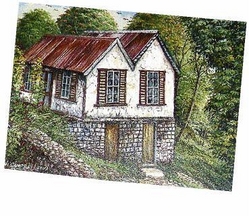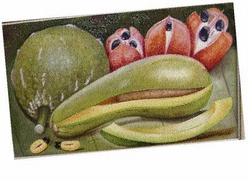

Contributed photos
LEFT: Webster Campbell painting.
RIGHT: Andy Ballentine painting
Wandeka Gayle, Gleaner Writer
The name Webster Campbell has become synonymous with the whimsical paintings of quaint, old country houses, just as the name Andy Ballentine brings to mind the realistic portrayal of Jamaican fruits and vegetables.
They may seem an unlikely duo with different artistic interests, but the two share several similarities, including a penchant for immortalising Jamaica's distinctive features through realism.
Both got together to exhibit their trademark work at the Gallery Pegasus under the theme 'The Best in Still Life and Landscapes', which opened on Friday, July 31, and will close on Saturday, August 29.
Campbell, with almost three decades in the art world under his belt and having exhibited both locally and internationally, said the show was his first local showcase in four years. He added that he felt that Ballentine, who came on the art scene more than nine years ago, was the best he had ever seen in the depicting of Jamaican food.
"I didn't want to have an exhibit where everybody was doing the same things over and over," Campbell said. "He is really good at fruits and I am good at old houses and I wanted to show that."
The show opened to a group of approximately 100 guests with guest speaker, Supreme Court Justice, A. Sinclair-Haynes.
The exhibit showcases 32 (acrylic on canvas) pieces of Campbell's new landscapes, houses and street scenes, which are actual scenes from rural Manchester, St Elizabeth and Trelawny.
"I get tired of seeing young artists do the same things over and over, like Bamboo Avenue and Dunn's River's falls," he said. "You have so many interesting scenes in Jamaica, like Stewart Town in Trelawny and Walkers Wood."
The exhibition also showcases 23 pieces of Ballentine's continuing study of a myriad of Jamaican food, including ackee, sugar cane and naseberry in oil on canvas.
The show displays pieces like Ballentine's portrayal of ackee pods with the yellow fruit protruding and set beside slices of avocado pear. One painting, dubbed 'Market Day', illustrates two large, red sweet peppers along with a chilli pepper beside a large cucumber. His other paintings represent everything from sweetsop to pumpkin.
Flair for tradition
Ballentine, like Campbell, has a flair for the forgotten traditions. One major motif in Ballentine's paintings is the old-fashioned straw baskets. For instance, he places his fruits in them for the study of Julie mangoes. The straw baskets are sometimes tilted at interesting angles to make it more aesthetically pleasing. He even adds a plaid kitchen towel with star apples to add interest.
Campbell opted to showcase various scenes in Porus, Franklyn Town, Walkers Wood and Stewart Town.
One piece showcases the heavily wooded Trelawny landscape with fingers of light shimmering through the trees.
A popular theme in his paintings is the lone country roads running through these rural communities, which pulls the eye to the decrepit yet bulwark-like architecture alongside it.
To render a building dilapidated means paying careful attention to details of items like cracks, rusting zinc, discoloration, faded paint. Campbell delivers this by adding texture to his two-dimensional paintings.
For instance, the painting 'Porus - Manchester' depicts one of these scenes with a lone car and three distant figures. Along the roadway, the wooden and stone structures of a bygone era sit with telltale signs of age and wear in the traditional burgundy and cream.
Old houses
The stonework of the old houses is carefully represented and the houses themselves seem as fragile as they do in reality.
Viewers are transported to these old-fashioned country scenes where Campbell deliberately represents the country houses somewhat off centre, as though ready to topple over leaving behind their aged brick foundations.
He even hints at the traditional red floors on the stone steps leading to the front door. The houses are also depicted with the traditional shutters and glass windows.
Campbell said his inspiration has always come from tramping the island to the unseen nooks and crannies to remind Jamaicans of their dying traditions.
"I try to put it on canvas because sometimes when you do this people will see how interesting Jamaica is," he said. "You know [hurricane] Gilbert come and destroy a lot of the old houses and I want to show the old architecture, the stone and daub houses in Mandeville, the wattle and daub houses in St Elizabeth, the board houses in western Jamaica."
In explaining his inspiration, Ballentine said he embraces the notion of 'having your cake and eating it too.' Acquiring his subject matter for his paintings is as easy as taking a trip to the market.
"I love to paint fruits because after you paint it you will always have it to look at. They are so unique and you can study down to their pores and the different colours," he said.
New shows
Ballentine, who has won several local awards for his art, said he has about a dozen new shows coming up later in the year, and will be re-introducing his experimentations with abstracts along with his usual subject matter.
He, along with Campbell who has exhibited in London, North Carolina and New York and himself a winner of juried art shows, will be showcasing new work at the Manchester Art Fair in November. Campbell promises more than landscapes. He also does figures and some still life of his own.
But, for now, their pieces are within reach at the Gallery Pegasus exhibition, which has been extended until Saturday.